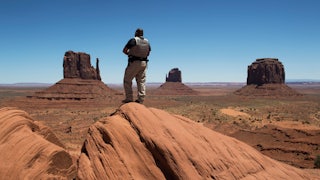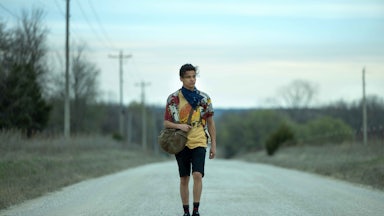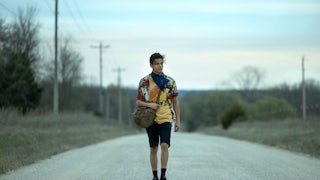Navajoland spans more than 27,000 square miles of sun-dried flatlands and ephemeral streams; of snow-capped mountains, oxidized crags; of campers, trailers, and small farms with no electricity or running water; of stubborn vegetation; of George Strait fans; of high unemployment; of heat-related illnesses and deaths; of students, artisans, addicts, truck drivers, bootleggers, government dignitaries, sheepherders, families; of dust. It’s the largest reservation in the country, roughly the size of West Virginia, pinned within three southwestern states. Yet despite its immensity, in 2022, the Navajo Nation, by one count, only employed around 180 police officers—130 if you include just those who venture out on patrol.
This is the central problem examined in Navajo Police: Class 57, a new HBO docuseries about last year’s round of fresh-faced recruits. We’re told throughout the three-episode run that crime within the Navajo Nation has surged since the pandemic. The response time to 911 calls is abysmally slow. If an officer rings for backup, they may wait up to an hour before reinforcements arrive. In one early scene, a woman complains that an assailant is “gonna come back with a knife,” to which the officer winces and replies, “OK, well, you just gotta call us back. That’s how it is.” There’s simply too much ground to cover, and too many calls coming in.
“People feel they don’t have any place to turn to for help,” says Sergeant Lucy Dan, an instructor at the police academy. A recent report ordered by the Navajo police showed the department needed 775 officers to “meet community demands.” Before the pandemic, police in Gallup, New Mexico—on the boundary with the Navajo Nation—recommended that business owners hire their own private security, and in the past they even outsourced 911 services dealing with “inebriates” and “transients” to armed guards. Now the Navajo Nation has invested hundreds of thousands of dollars of Covid relief funds to enhance police capabilities. In Class 57, a great deal is riding on the year’s 28 recruits.
Joining this underfunded and undermanned police force is not a simple decision. Growing up, many of the recruits’ lives were touched in some way by law enforcement. They want to make a difference but know enrolling will also change them. Around 15 minutes into the first episode, Lieutenant Donnie Kee explains to the new recruits, “You represent everyone that has ever worn that uniform.” Later, another commanding officer concurs: “You won’t be … nor do you get to be the same person you were when you entered this training.” Through the badge, they say, your personhood morphs. They’re now of the community and shorn from it, tasked with representing but also constricting it.
Directed by Kahlil Hudson, Alex Jablonski, and David Nordstrom (best known for Last Chance U and Cheer), Class 57 is the latest project from Concordia Studio, the brainchild of Davis Guggenheim (director of Waiting for Superman and An Inconvenient Truth) and Laurene Powell Jobs. The studio is perhaps best known for Barack Obama’s recent Netflix docuseries, Working, but Class 57 is closer in kind to Concordia’s At the Ready, a Trump-era documentary about Hispanic high school students in El Paso who train to become Border Patrol agents, corrections officers, and police. There, children don helmets that sometimes appear too big for their heads and compete in a paramilitary-style training program, all while flinching through the social abrasions one might expect when you cozy up to ICE in a town with among the highest immigration rates in the country.
For a school project, one student interviews a Border Patrol agent about the pros and cons of his job. The pros: It’s a good-paying career and has decent benefits. Indeed, law enforcement is one of the few career fields in El Paso with wages comparable to the national average, and in 2016, Latinos surpassed 50 percent of Border Patrol employees. The cons: “We provide gifts for low-income families for Christmas and turkeys for Thanksgiving,” and yet still, for some reason, civilians “see us as family wreckers.”
A similar dynamic plays out in Class 57, which starts by showing the bumpy initiation of the recruits. On the first day of training, the academy’s supervisors pop honey-flavored lozenges together to avoid harming their throats from all the screaming they’re about to do. Two police SUVs peel into the parking lot, sirens blaring, to corral the recruits toward the curb. The commanding officers bellow in recruits’ ears, throw the contents of their bags on the ground, and demand they pack them up over and over again. Through hazing “we’re applying stress,” explains Sergeant Rob Williams in a cutaway interview, “because we have to develop those neural pathways: Here’s what it’s like for someone to be in your face.”
Yet when we follow other officers on patrol, we see only one scene of close-up screaming. Instead, the overwhelming majority of perps caught on camera in Class 57 tend to run, hide in locked trailers, slump over in an intoxicated stupor, or cooperate unhappily. Mostly, we see fear. After the police kick down a mobile home door in response to a domestic violence call, a child off-screen asks them through sobs, “Are you guys gonna take me to Child Protective Services?” The rate of domestic violence in the Navajo Nation is 10 times higher than the U.S. average. “Without intervention,” Sergeant Dan says, “it will repeat itself and be learned by the next generation.”
It’s hard to escape the thought that the police are part of the cycle of violence. At the close of its second episode, Class 57 splices together footage of recruits being hazed and learning hand-to-hand combat with an introduction in what to expect on the job from victims of domestic violence (to begin the seminar, Sergeant Dan asks the recruits how many of them witnessed some kind of abuse growing up, and almost every hand in the room raises). As Dan’s voiceover continues, the sequence concludes with flashes of archival footage from the reservation, photos of U.S. frontier soldiers, the Navajo prison camp at New Mexico’s Fort Sumner, the boarding schools where Navajo children were sent to be split from their culture, and a final still shot of the American flag. It’s a stirring, if clunky visual metaphor: The police are both perpetrators of brutality, the show implies, and victims of it.
But as quickly as this thought appears, the next episode all but abandons it. The documentary does not spend time on the long-standing reasons why the community might be uneasy about law enforcement. In what became known as the Long Walk, over 10,000 Navajo people were forcibly removed from their land in 1864 and held in a prison camp 300 miles away—an attempted ethnic cleansing the U.S. government has not directly acknowledged to this day. A treaty four years later permitted the Navajo to return to a reservation on select portions of their homeland, mostly on sections that were not deemed valuable to American farmers. White settlers soon began complaining about stolen livestock, so in 1872, tribal members founded the Navajo Police Department to diminish tensions. Franklin Sage, director of the Diné Policy Institute, has argued that it was “a way of protecting settlers” and trying to “control and keep the Navajo within a certain area.” Since then, the Navajo Police Department has undergone several iterations, with its powers shrinking and expanding at the federal government’s whim. This history is a crucial window into what caused the community to distrust them, who they’re often policing, how, and why.
The Navajo police have never been fully autonomous. Today, tribal police can detain non-natives on their land, but they still lack jurisdiction to arrest them—that right remains within the sphere of American federal officers. The U.S. government still largely holds the key to funding, land use, and law enforcement on reservations. As such, the Navajo police system is a settler police system: Class 57 hints at this fact, occasionally focusing the camera on the officers’ Thin Blue Line merch. But questions about jurisdiction too largely remain unstated.
Before having a new legal system dropped on it, Navajo society relied on a process today called peacemaking, a dialogue between the perpetrator and victim based on healing and restoring dignity and trust. This too goes without mention. “Incarceration is an alien concept to traditional Native American societies,” noted the National Indian Policy Center in 1996. Now native Americans are incarcerated at more than three times the rate of white people, nearly double that of Hispanic people—not to mention the number of jail beds on reservations has more than doubled since 2000, driving a rapid increase in detentions. One of the more cogent critiques in Class 57 comes from an 18-year-old handcuffed in the back of a police cruiser: “Arresting me is not gonna do nothing, yo.”
By the end of Class 57, we’ve met scores of families, watched them hang tinsel on their Christmas trees, and seen what makes our officers tick. They’ve scrimmaged on the basketball court, skipped training to see a Metallica show instead, and one after the other, experienced the sting of pepper spray in a training scenario, forcing themselves to blink through the chemical burn while instructors insult them and smack them with punching pads. But why are they really here? Is the police department plagued with problems only because it doesn’t have enough boots on the ground? Because it doesn’t have enough funding?
In the third episode, we’re treated to graduation ceremonies and a flash-forward to a couple of months on the job. The number of recruits dwindled from 28 to just 10 by the end of boot camp. Three veterans of the force also submitted for their retirement, meaning the department gained just seven officers after months of training.
We see pain in the face of a new cadet named Shawvan Levi. He is on leave after witnessing a gunman attempt “suicide by cop.” His partner ended up pulling the trigger, aiming for the man’s legs to incapacitate him, but Levi froze up. It weighs on him that he didn’t take the shot at all. What if he had been alone? Would he still be here today? We see pain too in Andrea Gray, the wife of a recruit, who confesses when her husband comes home, “he’ll take his anger out on me.” It confuses her because she knows she didn’t do anything to him. She has to remind herself, “It’s not you, it’s what he’s going through at work.”
Class 57 excels in these quiet moments, but it elides the stickier contradictions that drive its drama, favoring instead a bleary humanism. Bookending the series, the former Navajo police Chief Ronald Silversmith tells us the folk legend of the twin warriors—“Hero Twins,” as they’re sometimes known, who slew many monsters to protect their homeland. When the remaining monsters fled, they told the twins they would return: “I’m going to take your songs,” they said, “I’m going to take your ceremonies. You’re going to go through hunger,” poverty, disease, and death. Some elders believe the prophecy is here, Silversmith says. He intends to show how the thin blue line is picking up the twins’ fight; the Navajo Nation is under attack, the thinking goes, and requires order to defend itself. But then, what if those you jail are only human?






